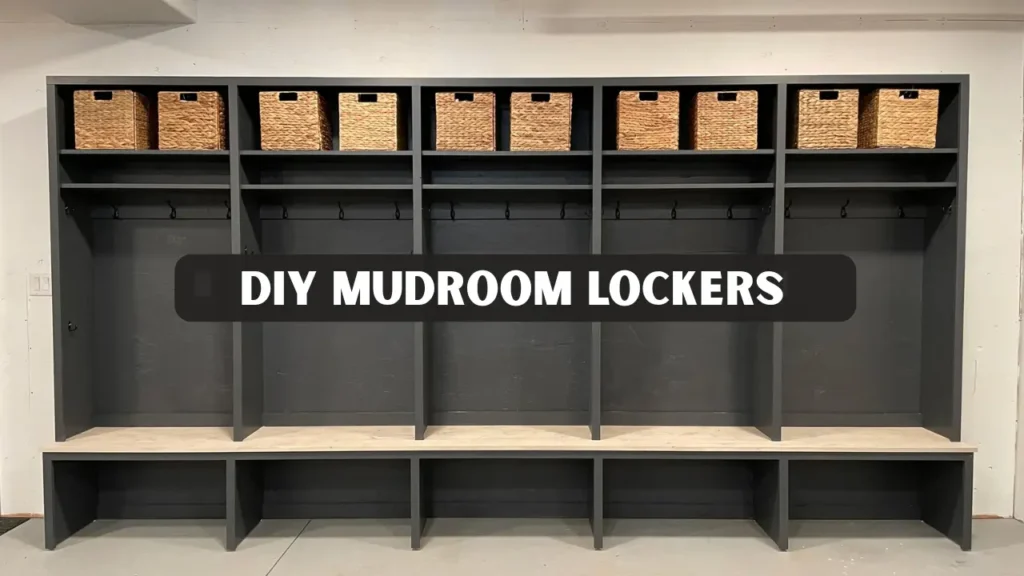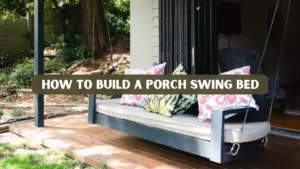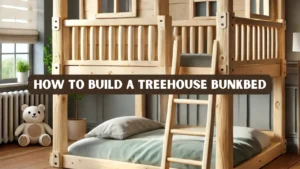An entryway is often the first space people see when they enter a home. Without proper storage, that space quickly becomes cluttered with shoes, coats, bags, and all the daily essentials. Building DIY mudroom lockers offers a practical solution. These lockers give each household member a dedicated spot, help maintain order, and add real value both functionally and aesthetically.
In this comprehensive guide, you will find everything you need to know about designing and building your own lockers from planning and materials to step-by-step construction, finishing touches, and common pitfalls. Whether you are a seasoned DIY enthusiast or trying your first major woodworking project, this article will walk you through with clear instructions and helpful insights.
Key Takeaways
- DIY Mudroom lockers built by yourself can transform a chaotic entryway into an organized, functional space where coats, shoes, bags, and daily gear have dedicated storage.
- Proper planning in advance including design, layout, materials, and budget makes building effective lockers much easier and ensures longevity.
- This guide provides a complete build plan: from design decisions to materials list, step-by-step assembly, cost estimate, finishing tips, and troubleshooting.
- You can complete a standard locker setup in one or two weekends, even with basic woodworking skills, and customize it to fit your home and lifestyle.
- Thoughtful finishing and styling choices help the lockers integrate smoothly into your home’s design and improve everyday usability.
Why a Dedicated Entryway Storage Matters
Many homeowners underestimate the importance of organized entryway storage. A well-designed locker system can make daily routines smoother, reduce clutter, and even improve home value. Here are the major benefits:
- Efficient daily flow: With a designated space for jackets, shoes, umbrellas, and bags, everyone can grab or store items quickly when leaving or entering the house.
- Reduced clutter: Instead of piles by the door or in corners, everything stays neatly stored, making the entryway look clean and inviting.
- Increased home value: Built-in storage solutions are attractive to buyers or renters since they show care for organization and home upkeep.
- Customization for your family’s needs: Whether you need bench seating, cubbies for kids, shoe shelves, or charging stations, a custom locker system adapts to you.
- Durability and longevity: When built with quality materials and proper techniques, lockers last years and withstand everyday wear.
Because of these advantages, many home-improvement enthusiasts and interior designers recommend lockers as a top entryway upgrade for both style and function.
Planning Your DIY Mudroom Lockers
Design decisions made up front will determine how your locker system performs and how well it integrates into your home. Use the following planning questions to guide your design phase:
- Who will use the lockers? Adults, children, pets, or a mix. Consider height differences and storage needs.
- What storage do you need? Shoes, coats, bags, seasonal gear, pet items, umbrellas, sports equipment. Also consider seating or bench space if you want a place to put on shoes.
- Will you include special features? Built-in charging ports, lighting (LED strips), baskets or bins, hooks, drawers, closed cabinets, open cubbies.
- Is this a permanent installation or a modular, semi-permanent solution? Wall-mounted built-ins require more robust construction and finish work; freestanding lockers allow flexibility and easier relocation.
- What are your space constraints? Measure wall length, depth, floor clearance, door swing, bench clearance, and overall height especially in spaces with low ceilings or baseboards.
Layout and Dimension Options
Here are some common layout configurations to consider:
-
Single-row lockers along a wall
-
Good for narrow entryways
-
Each locker contains a bench, shoe shelf below, and cubbies or hooks above
-
-
Bench-with-cubbies layout
-
Bench height with cubbies above for hats, bags, school supplies
-
Closed storage or open shelves below for shoes
-
-
Full-height built-in lockers
-
Floor-to-ceiling storage units covering an entire wall
-
Offers maximum storage but requires precise measurements and more material
-
Typical dimensions to follow:
- Locker depth: 15–18 inches (enough for coats, backpacks, and shoe storage)
- Bench height: 17–19 inches (standard seating height for comfort)
- Locker width: 24–36 inches per person (adjust based on household size and available wall space)
- Cubbies: 10–12 inches deep and 12–16 inches high suited for small items or bags
Planning correctly helps avoid problems like lockers being too shallow, doors colliding, or bench being too low to sit comfortably.
Materials and Tools Required
Having a clear materials and tools list before you begin will save time and minimize waste. Below are recommended options for a durable, attractive, and cost-effective build.
Recommended Materials
- Cabinet-grade plywood (¾”) :Use for the main structure: sides, top, bottom, shelves. Plywood provides strength and resists warping compared to particle board.
- 1×3 or 1×4 hardwood or pine: For face frames, trim, and support cleats. Adds sturdiness and a clean finish.
- MDF or hardwood boards: For doors, shelves, and bench top if a solid surface is desired. MDF gives a smooth surface for painting; hardwood offers a premium look for finished furniture.
- Wood glue, screws (1¼” and 2½”), wood filler, sandpaper (120–220 grit): For assembly, filling holes, and smoothing surfaces before finishing.
- Hardware: hinges (concealed or surface), drawer glides (if adding drawers), hooks, magnetic catches, bench support cleats, shelf pins (if using adjustable shelves).
- Paint or stain, primer, polyurethane or varnish for bench top (if left as natural wood).
Tools You’ll Need
- Circular saw or table saw (to cut plywood and boards to size)
- Drill/driver and countersink bit (for screws)
- Pocket-hole jig (optional, for clean concealed joinery)
- Tape measure, level, speed square, carpentry pencil (for accurate measurements and marking)
- Orbital sander or sanding block (for smoothing surfaces before finish)
- Brad nailer or finish nails (for trim and face frame attachment)
- Safety gear: safety glasses, dust mask, hearing protection
Having tools and materials ready before starting ensures a smoother build process and reduces the need for last-minute trips to the hardware store.
Step by Step Build Process
This is a step-by-step plan for building sturdy, attractive lockers. Follow each step carefully and work methodically for best results.
1: Measure and Plan the Layout
- Measure the wall where lockers will be installed: width, height (floor to ceiling), and depth available. Also check for obstructions like baseboards, light switches, outlet boxes, or molding.
- Sketch a layout on graph paper or use painter’s tape on the floor/wall to define the locker footprint.
- Confirm bench height clearance if you plan to seat people.
- Determine door swing if doors will be included.
Taking time to double-check measurements helps avoid errors that can become costly later.
2: Cut All Panels and Boards to Size
- Cut plywood panels for sides, top, bottom, fixed shelves, and bench base.
- Cut hardwood or pine boards for face frames, trim, and bench support cleats.
- Pre-cut door panels or trim to size if including doors.
Doing all cuts first helps maintain consistency and speeds up assembly.
3: Build the Locker Carcass (Frame)
- Assemble the carcass using wood glue and screws. Use 1¼” screws for plywood panels and countersink them to fill later.
- If using pocket-hole joinery, assemble with a pocket-hole jig for cleaner joints and easier assembly.
- Ensure the assembled box is square by measuring diagonals (they should match). Adjust if needed before glue sets.
4: Install Shelves and Dividers
- Add fixed shelves for shoes near the bottom. Position them 6–8 inches above floor for ventilation and easy cleaning.
- If you want adjustable shelves (for seasonal gear, bags, or boxes), drill holes for shelf pins or install fixed dado grooves.
- Add vertical dividers if you want separate sections for different family members or gear types.
5: Build and Attach Bench
- Construct bench support: install a horizontal support cleat across the back, and optionally a center cleat for extra strength.
- Attach plywood or hardwood bench top to supports using glue and screws. If using hardwood, leave it natural or stain; if painting, MDF or plywood works fine.
- Sand the bench top smooth and fill screw holes for a clean finish.
6: Add Doors, Trim, and Hardware
- Build paneled or shaker-style doors from MDF or hardwood. Use concealed hinges for a clean look, or surface hinges for a simpler installation.
- Attach hooks inside each locker for coats, bags, or hats. Install at 48–60 inches from floor for adults or lower for children.
- Add trim or face frames around the doors for a professional, finished appearance. Use 1×3 boards or similar for trim.
7: Sanding, Priming, and Painting or Finishing
- Fill screw holes and joints with wood filler. Sand all surfaces smooth from 120 to 220 grit for a smooth finish.
- Apply a high-quality primer on all surfaces, especially if using plywood or MDF, to seal pores and ensure uniform paint adhesion.
- Paint or stain lockers with a durable finish. Semi-gloss enamel is recommended for areas that get scuffed.
- If bench top is left wood or stained, apply two to three coats of polyurethane or varnish for protection against wear and moisture.
8: Final Assembly and Touch-Ups
- Reattach doors, hooks, and hardware. Adjust doors to ensure smooth opening and closing.
- Add baskets, bins, or storage containers in cubbies for seasonal gear like hats, gloves, or sports equipment.
- Clean the entire unit and let paint or stain dry completely before use (ideally 24–48 hours).
Following this step-by-step method ensures that your lockers are sturdy, functional, and visually pleasing, a result that will stand the test of daily use.
Cost Estimate and Budgeting Tips
Building your own locker system can be much more budget-friendly than buying pre-built furniture. Below is a rough estimate for a typical three-locker setup (approximately 6 feet wide) using mid-range materials:
- Plywood and lumber (carcass, shelves, bench base): $150–$250
- Hardware (hinges, screws, hooks, shelf pins): $40–$80
- Paint, primer, and finishing supplies: $30–$70
- Bench cushion or padding (optional): $25–$60
- Miscellaneous (glue, wood filler, sandpaper): $15–$30
Estimated total cost: $260–$490
If you choose higher-end hardwood, add drawer units, or include lighting/charging ports, the cost will rise accordingly.
Budget-friendly tips:
- Use paint-grade plywood or pre-finished boards instead of hardwood to reduce cost.
- Repurpose old furniture (e.g., old wardrobes or cabinets) to create locker sections.
- Buy hardware and paint supplies from discount retailers or bulk sellers.
- Stagger work over time for example, build carcass first and finish later when budget allows.
With a modest budget and some planning, a sturdy, attractive locker system can be built for under $300.
Style and Finish Ideas for Your Lockers
A well-designed locker can not only store items but also complement the aesthetics of your home. Here are some style ideas and finishing touches to make lockers blend with your interior:
Farmhouse Style
- Use shaker-style doors and a soft, muted paint color (e.g., off-white, pale gray).
- Install black or bronze iron hooks and hardware for a rustic feel.
- Optionally use a distressed paint finish or light sanding on edges for a weathered look.
Modern Minimalist Style
- Use flat slab doors without trim or paneling.
- Paint in neutral colors like charcoal, navy, or matte white.
- Hidden hinges and no visible hardware for a seamless, built-in look.
- Add integrated LED strip lighting inside cubbies for a sleek, modern touch.
Rustic or Natural Wood Style
- Use natural hardwood for bench top and trim (e.g., oak or pine).
- Stain wood a warm tone (honey, walnut, or chestnut) to emphasize grain.
- Use woven baskets or fabric bins in cubbies for a cozy, homey feel.
Family-Friendly Functional Style
- Label each locker with nameplates (wooden or metal) to help each family member claim a space.
- Add lower hooks or cubbies for children’s gear.
- Add a bench cushion for comfortable seating and built-in shoe trays under locker bottoms for easy cleanup.
Combining practical features with thoughtful styling ensures that your lockers do not look like a functional afterthought — they become a natural, attractive part of your home.
Real-World Example
- A family built a three-locker system with a bench and cubbies, reducing entryway clutter by 80 percent and providing each member a designated spot for shoes, coats, and bags.
- Another household installed four DIY mudroom lockers with overhead storage and shoe racks, which cut morning chaos in half and created a functional, stylish entryway that matched their home décor.
Common Mistakes and How to Avoid Them
Even with careful planning, mistakes can happen. Here are common pitfalls and how to avoid them:
- Doors warping or sticking: Use cabinet-grade plywood or properly acclimatized hardwood. Avoid MDF for wide doors without reinforcement. Consider adding a center batten if needed.
- Bench sagging: Use proper support cleats and a solid plywood base. For heavy use, add a cross support under the bench.
- Shelves too shallow or too narrow: Ensure shelves are at least 15 inches deep and wide enough to accommodate shoes and bags comfortably.
- Poor paint finish: Sand thoroughly between coats. Use primer on plywood or MDF to avoid blotchy paint absorption. Choose semi-gloss or satin paint for easy cleaning.
- Inaccurate cuts or misaligned assembly: Always measure twice, cut once. Use proper squaring techniques (diagonal measurements) before gluing or screwing.
By paying attention to these details, you increase the chances your lockers will look good and last a long time.
Conclusion
Building your own locker system is a practical, rewarding project that dramatically improves the functionality and appearance of an entryway. With careful planning, the right materials, and step-by-step execution, you can create a durable, attractive storage solution that fits your family’s needs and enhances daily routines.
DIY mudroom lockers offer a balance between storage, style, and personalization while remaining budget-friendly and within reach for a motivated DIYer. Whether you want a simple bench and cubby setup or a full-height built-in storage wall, this guide gives you the blueprint to make it happen.
If you proceed with building, beginning with accurate planning and proper materials is key. Once completed, you will have a custom, functional locker system that helps keep your home organized and welcoming.
Frequently Asked Questions
How long does it take to build a typical locker setup?
A basic locker system three lockers with bench and shelves can typically be built in one to two weekends (about 10–15 hours of labor), depending on tools, experience, and complexity.
What type of wood is best for building lockers?
Cabinet-grade plywood (¾”) is recommended for the main structure because it provides strength and resists warping. Doors and trim can be made from hardwood or painted MDF depending on your budget and desired finish.
Can I add electrical outlets or lighting inside the lockers?
Yes. If you plan to add outlets or integrated lighting, map out wiring before building. Use a licensed electrician to install outlets safely. For lighting, LED strips are a simple, low-voltage option that adds convenience.
Do I need professional carpentry skills to build DIY mudroom lockers?
No. Basic DIY woodworking skills; measuring, cutting, drilling, sanding are sufficient. If you are uncomfortable with complex cuts or finishes, you can build a basic carcass and hire a local carpenter to assist with trim, doors, or installation.
How can I make lockers safe and child-friendly?
Use soft-close hinges or magnetic catches to avoid slamming. Mount hooks and cubbies at lower heights for children. Use baskets with no sharp edges. Ensure bench and shelves are sturdy.




